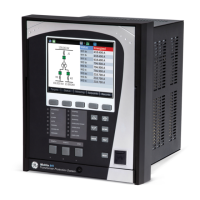4–74 845 TRANSFORMER PROTECTION SYSTEM – INSTRUCTION MANUAL
SYSTEM CHAPTER 4: SETPOINTS
The switching will not be performed if the frequency from the alternative reference
signal is detected invalid. Upon detecting valid frequency on the main source, the
tracking will be switched back to the main source. If a stable frequency signal is not
available from any source, then the tracking frequency defaults to the nominal system
frequency.
FAST PATH:
In cases when the 845 relay is ordered with phase voltage inputs, but voltages are not
available on the relay (no PTs, or voltage reads zero), the source for frequency tracking is
the CT bank from the same card, as the voltage bank. For 845 relay orders without VT
inputs, the source for frequency tracking is K1 - the first CT bank from the card residing in
K-slot. In this case automatic changing of the frequency source is not permitted
VOLTAGE FREQ TRACKING SOURCE
Range: Ph VT Bnk1-J2, Ax VT Bnk1-J2
Default: Ph VT Bnk1-J2
Transformer
INTRODUCTION
The percent (biased) differential protection is the main protection for power transformers
with regards to detecting all types of transformer internal fault. This protection is based on
Kirchoff’s law, where the sum of all currents flowing in and out of the protected equipment
equals zero. However, when applying this law to the overall differential protection, one
must keep in mind that the direct summation of the measured currents per-phase, does
not automatically result into zero differential current. This is because:
1. The transformer voltage ratio defines different winding nominal currents
2. The winding CTs are not rated to the exact match of the winding nominal currents
3. Physically, the transformer windings are connected in Delta, Wye or Zig-Zag
configuration, and they introduce a phase shift.
For the correct performance of the overall percent differential protection, it is necessary to
correct the magnitude and phase relationships of the CT secondary currents for each
winding, in order to obtain near zero differential currents under normal transformer
operating conditions. Traditionally, the phase shift between the currents from the
transformer windings has been corrected by connecting the CTs from the Wye winding in
Delta connection, and the CTs from the Delta winding in Wye connection. In the past, the
magnitude correction has been accomplished using interposing CTs, or tapped relay
windings. This however is not required any more when installing the 845
relay.
The 845 relay simplifies the process by performing the magnitude and phase shift
compensations automatically (internally). Upon entering settings for the protected
transformer and winding CT ratings, the relay automatically calculates and applies the
correct magnitude scaling to the winding currents as well as applying the correct phase
shift in order to prepare the currents for summation. To perform the correct currents
compensation, all winding CTs need to be connected in Wye (polarity markings pointing
away from the transformer). When the Tap Changer detection feature is enabled on the
relay, the algorithm automatically compensates the currents for the differential
computation based on the new voltage ratio corresponding to the detected tap.

